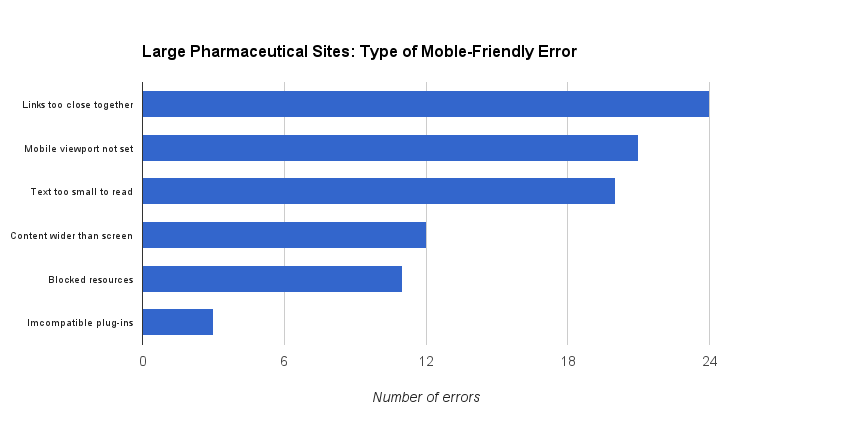April 17, 2015: Today Didit looks at “big pharma,” large pharmaceutical companies listed on Wikipedia’s list of the world’s biggest, most influential drug companies. Although these companies are well-funded entities whose site maintenance budgets likely comprise a very small share of their operating expenses, we found that the majority of them are not mobile-friendly.
This study is the latest in Didit’s pre-4/21/15 series of “mobilegeddon” evaluative surveys, which, to date, have included:
Mobilegeddon update: [fergcorp_cdt_single date=”21 April 2015″].
a) Major U.S. PR Firms (published 4/2/15)
b) Large-cap companies on Long Island (published 4/6/15)
c) Major New York-based advertising agencies (published 4/9/15)
d) Major U.S. charities (published 4/14/2015)
e) Major “white shoe” law firms in the U.S. (published 4/15/15)
f) Big CPA/accountancy firms (published 4/15/16).
g) Top-rated New York-area hospitals (published 4/17/2015)
h) S&P 100 companies (published 4/17/2015)
i) Lawyers on Long Island (published 4/17/2015)
Methodology
Didit ran each pharmaceutical company site through Google’s Mobile Friendly Test application page (https://www.google.com/webmasters/tools/mobile-friendly/) to see whether Google considers each site “mobile-friendly.” The specific error types causing any test failures were logged, and a screen capture was made of each report. Testing was begun and concluded on 4/13/2015.
Here is a summary of Didit’s findings:
1. 43 percent (18) of the 42 pharmaceutical firm sites surveyed are fully “mobile-friendly” according to Google’s definition.
2. The most common errors seen on the 24 sites failing Google’s Mobile Friendly test were:
a). Links spaced too closely together to be easily clicked on mobile devices. 24 sites had this error.
b) Mobile viewports not being set correctly. This error can cause the site to render in less than 100 percent of mobile display space. 21 failing sites had this error.
c) Text being set at a size too small to read on mobile devices. 20 failing sites had this error.
d) Content wider than screen. This error can cause the site to become arbitrarily “cropped” along the horizontal dimension when viewed on a mobile device. 12 failing sites had this error.
e.) Blocking of resources necessary for the Googlebot to correctly parse the resources referenced by the web page. 11 sites had this error.
f) Incompatible plug-ins. The use of plug-ins (for example, Flash) that render well only on desktop devices is discouraged by Google’s mobile algorithm. 3 failing site had this error.
Analysis
 Although large pharmaceutical sites do not use their web sites to make any direct sales to consumers, they do rely on them for branding, recruiting, PR, and other important internal purposes. Given that these companies are well-financed, it is not clear why the Mobile Friendly pass rate for this sector is only 44 percent, well below the benchmark 74 percent pass rate established by the S&P 100.
Although large pharmaceutical sites do not use their web sites to make any direct sales to consumers, they do rely on them for branding, recruiting, PR, and other important internal purposes. Given that these companies are well-financed, it is not clear why the Mobile Friendly pass rate for this sector is only 44 percent, well below the benchmark 74 percent pass rate established by the S&P 100.
A sector pass rate of 43 percent isn’t the lowest we’ve seen, but it in our view should be improved if large pharma sites want to be prepared to reach users on mobile phones. Digital marketing consultancy firm Emarketer.com has observed that “2015 will see mobile search reach the tipping point — the stage at which the majority of spend, organic traffic, and paid clicks comes from smart phones and tablets.”
The fact that a given pharmaceutical site fails to pass Google’s Mobile Friendly Test does not mean that it will be invisible or inaccessible on mobile devices. But Google has indicated that poor showings on this test may result in less visibility in search results made from mobile devices under certain circumstances.
Didit’s findings should not be cause for panic in the C-suite. In most cases the actual problems causing a “Fail” on Google’s Mobile Test can be quickly resolved — sometimes in under an hour. But because pharma firms have only a few days to rectify these problems, senior management should take this issue seriously and make any corrections required in time for the 4/21/15 deadline.
- 10 Mistakes to Avoid When Using QR Codes for Marketing - September 20, 2023
- Kevin Lee on How AI Changes the SEO Landscape - August 31, 2023
- The Power of Compound Marketing: Kevin Lee Presents @ 1MediaWorld 2023 Global Conference - March 7, 2023



